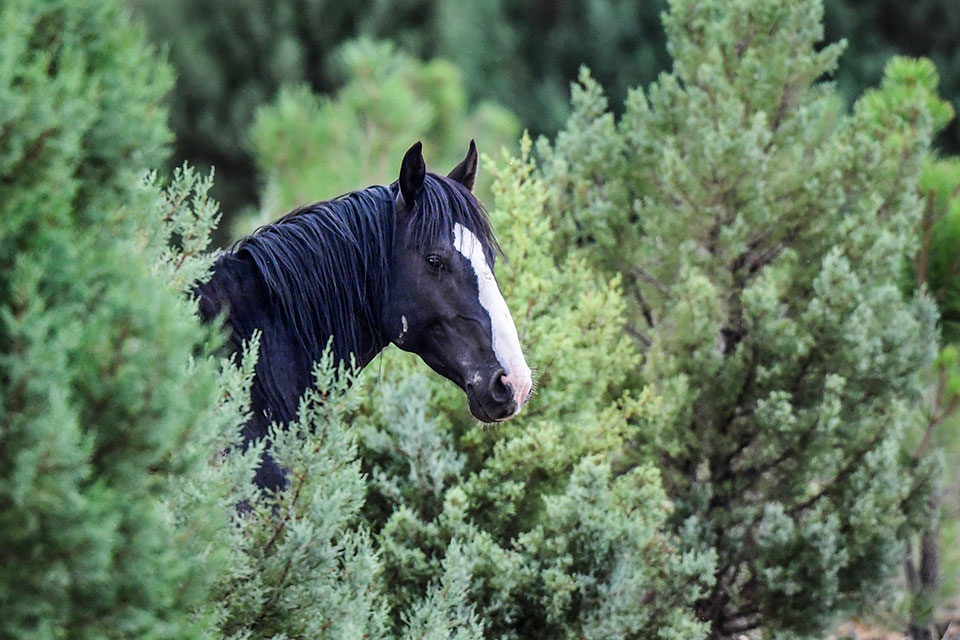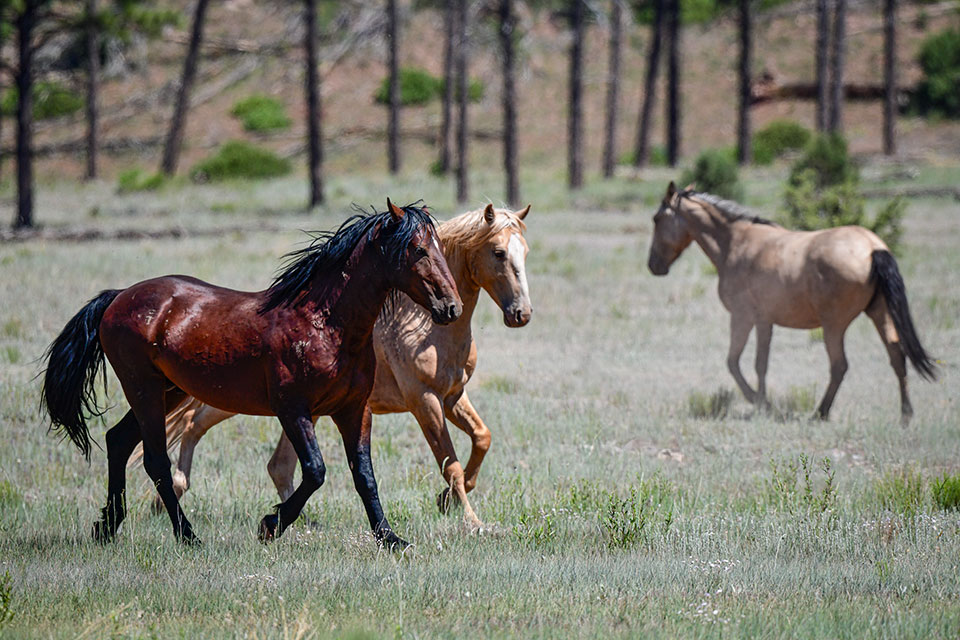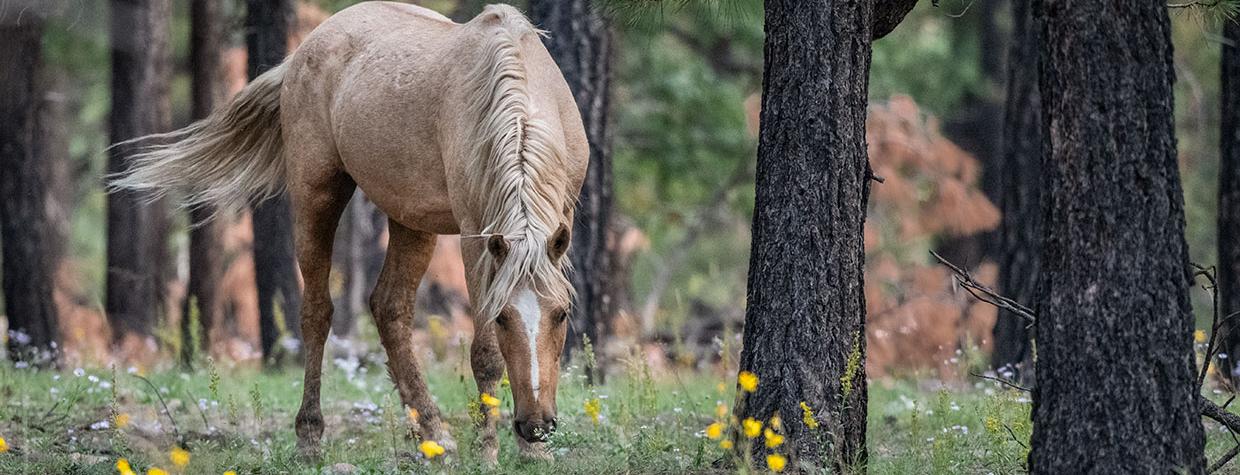Six years ago, William E. Simpson II was serving as a local adviser to crews battling the 2018 Klamathon Fire. He watched as flames raced toward his rural community, just south of the Soda Mountain Wilderness on the California-Oregon state line. Moving at an average speed of 4 mph, the fire was devouring everything in its path, Simpson says, until it reached an area where wild horses had grazed on grass and brush. “Suddenly, it goes from 100-foot-tall flames to flames that are 10 to 12 feet tall,” he recalls, “and the whole thing changes.”
Suppression efforts, he says, became more effective in the grazed area. And while the fire ultimately burned 38,000 acres and destroyed 83 structures, Simpson’s home and some ranches in the community were spared. Simpson is convinced the mustangs saved lives and property — by grazing away some of the fuels that fed the flames.
Few subjects inspire more passion than wild horses, and visitors travel to Arizona from around the world to catch a glimpse of the state’s herds. Protected as cultural icons, mustangs symbolize the freedom and independence of the West. But those same horses frequently come into conflict with human interests.
Those who question whether mustangs belong on public lands include an unlikely coalition of ranchers, hunters and environmentalists who say horses compete for forage and wreak environmental havoc. Land managers are caught in the middle, hampered by strong feelings on both sides and laws some people believe are outdated.
Simpson’s answer is to remove mustangs from areas of economically driven conflict and put them in wilderness areas to graze on the excess fuels that can lead to catastrophic wildfires. He’s dubbed his idea the Wild Horse Fire Brigade, and his nonprofit of the same name includes board members in Arizona who don’t see why the idea can’t work here. But not everyone is convinced — and before the idea could become policy, a lot would have to change.

The Klamathon Fire was one of 8,500 that burned through California in 2018, causing nearly $150 billion in economic losses. (That number includes predicted health effects from smoke, which were cited as a factor in Simpson’s wife’s death in 2019.) And all over the West, the frequency of wildfires has been steadily rising: Over the past half-century, the number of fires in the Southwest has increased by 462 percent in an annual fire season that’s now more than three months longer.
In Arizona, Coconino County officials recently identified wildfire and post-fire flooding as the area’s top public safety threats. The county estimates it has spent $100 million since 2010 responding to eight major wildfires and the floods that followed. County officials have applied for a grant to develop a wildfire protection plan that would make the county eligible for federal matching grants to thin forests in key areas.
Elsewhere in Arizona, the buildup of fuels was a significant factor in the catastrophic 2011 fire that burned most of Chiricahua National Monument, where nearly all of the land is designated wilderness. The blaze left only small patches of mixed-conifer and pine stands.
Nationally, federal agencies requested $4.3 billion for wildland fire and fuels management for 2024. Meanwhile, the Bureau of Land Management spent $108.5 million last year to care for the mustangs in its holding facilities, many in long-term pastures in Kansas and Oklahoma.
Those numbers don’t make sense to Simpson. He estimates that each of the horses now in holding facilities could provide $72,000 worth of grass- and brush-clearing services over its lifetime in the West, in addition to reducing losses caused by catastrophic fires. His plan would also allow the mustangs to live free of human interference, as he believes nature intended.
Horses evolved in North America. Most scientists believe they became extinct on the continent around 10,000 years ago before being reintroduced by Spanish explorers in the late 15th century. A smaller number believe they’ve been here all along. In either case, by the 1800s, vast mustang herds roamed throughout the Great Plains and the West.
Some were captured and put to work. But as motor-powered vehicles decreased the need for horses and competition with cattle on grazing lands increased, “mustangers” sent huge numbers of wild horses to slaughter. By the 1950s, only about 25,000 wild horses remained.
Around that time, Velma Bronn Johnston, nicknamed “Wild Horse Annie,” began encouraging elementary-school students all over the country to write letters to public officials, urging them to save wild horses. In 1959, the “Wild Horse Annie Act” made it illegal to use aircraft or motor vehicles to hunt horses on public lands. But it wasn’t until 1971 that wild horses were fully protected by federal law.
In unusually poetic language, the Wild Free-Roaming Horses and Burros Act calls wild horses “living symbols of the historic and pioneer spirit of the West” and protects them from “capture, branding, harassment or death” on the public land where they roamed in 1971. Today, wild horses and burros roam some 27 million acres in 10 Western states. In those areas, horses are managed “as an integral part of the natural system.”
But outside of them, they’re considered unauthorized livestock and the government must remove them at a property owner’s request.
The BLM oversees most of the places where mustangs and burros are protected, in 177 “herd management areas”; Nevada contains about half the acreage the agency manages under the program. The U.S. Forest Service supervises an additional 34 active wild horse and burro territories. By law, both agencies manage these lands for multiple uses, including hunting and livestock, and set population goals for horses and burros to maintain an ecological balance.
Much of that land overlaps grazing allotments, where natural predators have been reduced or eliminated. Without those natural controls, horse populations can grow by 15 to 20 percent a year. In 2023, an estimated 82,883 wild horses — more than three times what land managers believe the terrain can support — roamed public lands.
The roundups and fertility control measures used to reduce the horses’ numbers are costly and controversial. The BLM created an adoption incentive program that placed about 8,000 mustangs in homes last year, but some 62,000 remain in short-term holding corrals or long-term pastures.
In Arizona, two of the BLM’s eight herd management areas contain mustangs. The bureau’s deputy state director for resources and planning, Gerald Davis, says the most recent combined count of wild horses, in 2021, totaled 450 — more than twice what the BLM believes these areas can sustain. The number of mountain lions in the Cerbat Herd Management Area, north of Kingman, has kept the mustang population there relatively stable.
But that’s not the case across the state in the Heber Wild Horse Territory, managed by the Forest Service. In 2002, the Rodeo-Chediski Fire burned fencing along the neighboring White Mountain Apache Tribe boundary, swelling the population of the Heber herd. Without sufficient predators, the herd quickly grew. In the last census taken before the fire, the Forest Service estimated the mustang population in the territory to be in the single digits, but recent estimates have ranged from 600 to more than 2,000 mustangs roaming throughout the Apache-Sitgreaves National Forests. Many of them are outside the unfenced territory and have been a source of contention with ranchers — just the kind of conflict Simpson’s plan aims to eliminate.

Central to Simpson’s plan is the concept of “rewilding.” Originally coined in the 1990s, the term refers to taking a more hands-off approach to land management than conventional conservation practices, thus allowing ecosystems to self-regulate over time.
The world and its climate are changing, says Julie Murphree, an assistant teaching professor in animal science and wildlife conservation at Arizona State University and an equine science adviser for the Wild Horse Fire Brigade. Species adapt in ways that can be hard to untangle, she notes — the tamarisk, for example, isn’t native to the Salt River, but endangered Southwestern willow flycatchers now nest in it. Instead of trying to restore or maintain landscapes at some historical baseline, Murphree says, the rewilding approach is to let an area go for a while and see what happens. The result might be a novel, but balanced, ecosystem.
Rewilding proponents see horses as prime candidates for such experiments. Wild horses, Murphree says, have a broader dietary range than cattle and consume a diverse array of plants. They also eat more vegetation relative to their body weight, and their less-efficient digestive system allows seeds to pass intact in their manure, which acts as compost — “kind of like mowing your yard and reseeding it,” Murphree says.
Additionally, horses graze closer to the ground than cattle, which Murphree says helps foster a varied landscape of short and tall patches of grass. And their willingness to explore rugged terrain and steep slopes, where cattle won’t go, influences their grazing patterns and habitat selection, which contribute to overall landscape diversity, Murphree says.
But there’s not much research about rewilding or the ability of herbivores to moderate fire, and even fewer studies that focus on equines. In a review of 21 studies that assessed the effects of herbivores on fire frequency, 13 found that grazing reduced the number of fires. In some cases, herbivores created conditions for more frequent but lower-intensity fires. But overgrazing can have the opposite effect by reducing cover grasses and encouraging more-flammable woody plants to grow in their place.
The authors of that review found that herbivores reduce fuel load most effectively when grazing and browsing herbivores are combined and when herbivore food preferences match local vegetation. They concluded that using herbivores as ecosystem engineers is more cost-effective than reducing fuels mechanically, and they recommended using wild and semi-wild herbivores in wilderness areas.
So far, the BLM isn’t convinced. The agency’s website addresses the topic directly, pointing out that it’s against the law to introduce horses into new areas and expressing concerns about uncontrolled growth and damage to the environment. In some places, overpopulated mustang herds have degraded the environment and displaced other species, including pronghorns, elk and bighorn sheep. And in Arizona, the Center for Biological Diversity in recent years has sued the Forest Service for riparian-area damage it says horses and cattle inflicted in the Apache-Sitgreaves National Forests and along the Salt River.
Murphree believes frequent monitoring and adaptive management could mitigate any negative effects — it’s something the BLM and Forest Service do all the time, she says. But Congress designated wilderness areas to be maintained without human interference, Davis notes, and there are restrictions on how monitoring can happen there. Some of Arizona’s herd management areas overlap wilderness areas, but the BLM isn’t legally permitted to manage the wilderness portions the way it does the non-wilderness portions, and there aren’t any studies that analyze whether introducing horses would benefit these areas or be compatible with the Wilderness Act of 1964. “The desert ecosystem is so slow-recovering,” Davis adds, “that once those impacts are here, they’re here for a long time.”
What’s more, the BLM in Arizona has only three wild horse and burro specialists to monitor 4 million acres. “Anything that says ‘frequent’ when it comes to monitoring would give me pause or concern about having the resources to be successful,” Davis says.
So, today, mustangs continue to be what conservation biologists call a wicked problem — complex and difficult to define, with many interested parties who have conflicting interests and values. And the question of the benefits and drawbacks that mustangs have as ecosystem engineers in wilderness areas is far from settled. The idea is gaining traction. But for now, at least, the one thing many people seem to agree on is that a lot more research needs to be done.
To learn more about the Wild Horse Fire Brigade, visit wildhorsefirebrigade.org.

